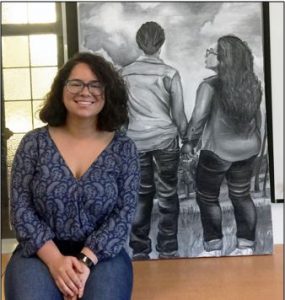November 2, 2017
 Audrey Sanchez found her way to the art therapy profession following her experience as an art teacher in Miami for six years, working with children ages 6 to 12. Presently a first year student in the Graduate Art Therapy Program at Florida State University, Audrey is interning at Pediatric Healthcare for kids in Tallahassee. For Audrey, art therapy is effective because art transcends languages and creates a common ground for clients to feel comfortable expressing themselves non-verbally.
Audrey Sanchez found her way to the art therapy profession following her experience as an art teacher in Miami for six years, working with children ages 6 to 12. Presently a first year student in the Graduate Art Therapy Program at Florida State University, Audrey is interning at Pediatric Healthcare for kids in Tallahassee. For Audrey, art therapy is effective because art transcends languages and creates a common ground for clients to feel comfortable expressing themselves non-verbally.
Within art therapy, social justice, diversity, and advocacy are very important to Audrey. As the proud daughter of two immigrants from Peru and Cuba, diversity in this career path is significant to her because she would like to help reach diverse communities with educational opportunities in art therapy.
Audrey has found her student membership with the AATA to be an essential asset and cites the Journal as one of the many benefits of membership, to help her better prepare for my classes and future clients, and development of a research proposal. Audrey says that she “felt connected to AATA in conjunction with the Art Therapy: Healing with the HeART initiative launch, held on October 18 at FSU. It was great to talk with AATA representatives and other students and faculty at the event. Soon I will also have the opportunity to travel to Albuquerque for the AATA’s annual conference where I will be able to attend workshops and talk to practicing art therapists from around the country.”
In further reflecting on the October 18th event, Audrey shares her experience as part of the FSU Graduate Art Therapy Program’s student and faculty team that met with Second Lady Karen Pence, as well as Florida’s First Lady, Ann Scott. Audrey had the opportunity to display and describe a reflective art piece about her personal experience of coming out as a member of the LGBTQIA community, and the Pulse Nightclub tragedy (see inset photo, above). Audrey shared the following with Second Lady Karen Pence and Mrs. Ann Scott:
“After the Orlando Pulse club tragedy on June 12, 2016, I needed a way to process what happened. It was personally upsetting not only because of the loss of life but also because three days before the incident I came out to my parents. Although the LGBTQIA community has many allies, as seen by this incident there are still people who fear what they don’t understand and react violently to this fear. This was frightening to my parents and even though I was scared I channeled that fear into my art. Now that I am in the FSU Art Therapy program I am able to contemplate this from a different perspective and I realize now that I used my paintings to cope with this fear.”
Audrey’s painting series consisted of portraits of allies and members of the LGBTQIA community. The painting Audrey discussed with Mrs. Pence and Mrs. Scott was her termination piece to show that the end concept of this series was the equality of love. She explained to them that the background of each piece has clouds that symbolize the victims of the Pulse tragedy. Reflecting on this experience and the fear she was feeling during this time, she realized that not only did she want to pursue a career that would allow her to help the survivors of this traumatic event, but also the first responders, such as those who assisted with the tragedy in Las Vegas and after natural disasters. These brave women and men witness traumatic events every day and need our help to cope.
In Audrey’s words, “When I learned of Mrs. Pence as an individual and how she wanted to help art therapy, I saw this as an opportunity to be part of the history of art therapy, part of a pivotal moment that can be huge in helping. I found Mrs. Pence to be receptive, that she wanted to know more about my experience, and that she was really taking in what I was saying. What I really got a sense of was that Mrs. Pence’s views on the field have evolved greatly since she first began this initiative, and she clearly remains open-minded in seeing how expansive the field can be and how art therapists can reach many different types of people. I am pleased to have had the opportunity to speak with her. We are taught in this program how we need to go out and advocate for this field, and reach out to a whole range of people who have different perspectives, and take the opportunity to educate others.”

Audrey Sanchez, Becca. Oil on canvas.
